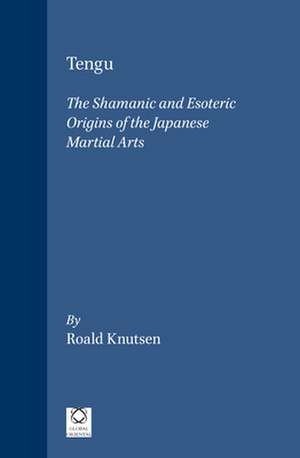Tengu: The Shamanic and Esoteric Origins of the Japanese Martial Arts
Autor Roald Knutsenen Limba Engleză Hardback – 14 aug 2011
According to Roald Knutsen, who is widely known for his writings on the samurai tradition, prompting his life-long study of tengu – the part-human, part-animal creatures – was the early discovery that the tengu of the Muromachi period were interacting with the deadly serious bugei masters teaching the arts of war. Here were beings who did not conform to the comic, goblin-like creatures of common folklore and were not the creations of the Buddhist priests intent on demonizing that which they did not understand and could not control.
As this study shows, the part-hidden tengu under review passed on and taught the clearest theory of tactics and strategy to bushi of the highest calibre, the absorption and mastery of which often decided if the warrior and his clan lived or were annihilated on the all-too-frequent killing grounds of the Muromachi age.
Tengu will be widely welcomed in many contexts including studies relating to martial arts, religion and folklore, shamanism and mythology, and the social and military history of Japan.
Preț: 394.16 lei
Preț vechi: 463.72 lei
-15% Nou
Puncte Express: 591
Preț estimativ în valută:
75.43€ • 78.09$ • 63.76£
75.43€ • 78.09$ • 63.76£
Carte indisponibilă temporar
Doresc să fiu notificat când acest titlu va fi disponibil:
Se trimite...
Preluare comenzi: 021 569.72.76
Specificații
ISBN-13: 9781906876227
ISBN-10: 1906876223
Pagini: 245
Dimensiuni: 155 x 235 x 25 mm
Greutate: 0.59 kg
Editura: Brill
Colecția Brill
ISBN-10: 1906876223
Pagini: 245
Dimensiuni: 155 x 235 x 25 mm
Greutate: 0.59 kg
Editura: Brill
Colecția Brill
Cuprins
Introduction; The Tengu; About Shamanism in the Present Context; Communing with the Gods; Origins, Cultic Symbols; The Transition from the Griffin to the Hawk and Crow; Shamanism and the Japanese Context; The Transition from the Ancient to the Medieval Period; The Introduction of the Buddhist Mikkyō; Were ‘The Protectors’ the Proto-Yamabushi?; Comparisons; Apparitions; Tengu Weapons and Other Items; Dai-tengu and Shō-tengu in the Iconography; Messenger of the Deities; Bugei Tengu Iconography; Marishit-ten and ‘Divine Assistance’; Tengu Revisited.
Notă biografică
Roald Knutsen (1933– ) was born in Hertfordshire of Anglo-Norwegian parents and educated at The Perse School, Cambridge, and Watford Grammar School. After studying Art and Design he served as a regular in the Intelligence Corps and followed with a successful career in graphic design, choreographing complex medieval combat sequences for a computer film project in England and the USA, and writing.
For the past half-century he has practised traditional Kenjutsu, Kendo, Iai-jutsu, and So-jutsu under a succession of famous Japanese masters, having menkyo-kaiden (senior master’s licence), in one of the oldest transmissions of Iai-jutsu, and the rank of 6th dan Renshi in Kendo. He has researched and written extensively about the Japanese warrior traditions and aspects of Japanese history.
He is also the author of Japanese Polearms (1963), Rediscovering Budo ( Global Oriental 2004), Japanese Spears, which he co-authored with his wife Patricia Knutsen (Global Oriental 2004) and Sun Tzu and the Art of Medieval Japanese Warfare (Global Oriental 2006).
For the past half-century he has practised traditional Kenjutsu, Kendo, Iai-jutsu, and So-jutsu under a succession of famous Japanese masters, having menkyo-kaiden (senior master’s licence), in one of the oldest transmissions of Iai-jutsu, and the rank of 6th dan Renshi in Kendo. He has researched and written extensively about the Japanese warrior traditions and aspects of Japanese history.
He is also the author of Japanese Polearms (1963), Rediscovering Budo ( Global Oriental 2004), Japanese Spears, which he co-authored with his wife Patricia Knutsen (Global Oriental 2004) and Sun Tzu and the Art of Medieval Japanese Warfare (Global Oriental 2006).
